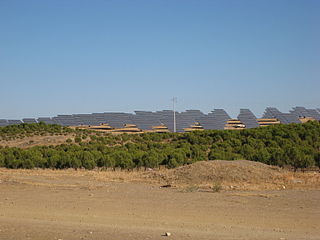
Nevada Solar One is a concentrated solar power plant, with a nominal capacity of 64 MW and maximum steam turbine power output up to 72 MW net (75 MW gross), spread over an area of 400 acres (160 ha). The projected CO2 emissions avoided is equivalent to taking approximately 20,000 cars off the road. The project required an investment of $266 million USD, and the project officially went into operation in June 2007. Electricity production is estimated to be 134 GWh (gigawatt hours) per year.

Renewable energy plays an important and growing role in the energy system of the European Union. The Europe 2020 strategy included a target of reaching 20% of gross final energy consumption from renewable sources by 2020, and at least 32% by 2030. The EU27 reached 22.1% in 2020, up from 9.6% in 2004, but declined to 21.8% in 2021. These figures are based on energy use in all its forms across all three main sectors, the heating and cooling sector, the electricity sector, and the transport sector.

Many countries and territories have installed significant solar power capacity into their electrical grids to supplement or provide an alternative to conventional energy sources. Solar power plants use one of two technologies:

The Waldpolenz Solar Park is a 52-megawatt (MW) photovoltaic power station built by German developer and operator Juwi at a former military air base near Leipzig, Eastern Germany. When completed by the end of 2008, it was the world's largest thin-film solar park using CdTe-modules.

ACCIONA Energía, a subsidiary of Acciona. Is a company dedicated to providing solutions based on renewable energy, with the goal of contributing to the decarbonization of the planet.

The Moura Photovoltaic Power Station is a large photovoltaic power station in Amareleja, in the municipality of Moura, Portugal. It is one of the largest power stations of its kind, and is built in one of the sunniest regions in Europe. Its construction involved two stages: stage 1 was completed in 2008 after 13 months, and stage 2 was completed in 2010. The entire project exceeded a total cost of €250 million.
The Rote Jahne Solar Park in Saxony, Germany, has a total output capacity of 6 megawatts peak (MWp). Built at a former military airfield, it has 90,000 First Solar thin-film modules covering approximately 6.7 hectares, and produces approximately 5.7 million kilowatt-hours (kW·h) of solar electricity every year. The project cost around Euro 21 million or US$28 million.

EDF Renewables is a wholly owned subsidiary of the French utility EDF Group, specializing in renewable energy production. As an integrated operator, the Group develops and finances the construction of renewable energy facilities, and manages operations and maintenance for its own account and for third parties.

A photovoltaic power station, also known as a solar park, solar farm, or solar power plant, is a large-scale grid-connected photovoltaic power system designed for the supply of merchant power. They are different from most building-mounted and other decentralized solar power because they supply power at the utility level, rather than to a local user or users. Utility-scale solar is sometimes used to describe this type of project.

As of the end of 2014, solar power in Austria amounted to 766 megawatt (MW) of cumulative photovoltaic (PV) capacity, of which more than three quarters were installed within the last four years. Solar PV generated 766 gigawatt-hours, or about 1.4% of the country's final electricity consumption. As with most other European countries, 99.5 percent of all solar power systems are connected to the electrical grid. The nation's installed PV capacity by inhabitant stood at 91 watts, still below the European Union's 2014-average of 172 watts.

Solar power in Mexico has the potential to produce vast amounts of energy. 70% of the country has an insolation of greater than 4.5 kWh/m2/day. Using 15% efficient photovoltaics, a square 25 km (16 mi) on each side in the state of Chihuahua or the Sonoran Desert could supply all of Mexico's electricity.

Solar power in South Africa includes photovoltaics (PV) as well as concentrated solar power (CSP). In 2016, South Africa had 1,329 MW of installed solar power capacity. Installed capacity is expected to reach 8,400 MW by 2030.

Solar power in Belgium reached an installed capacity of 4,254 MW of power generating 3,563 GWh of electricity in 2018. In 2015 PV solar power accounted for around 4% of Belgium's total electricity demand, the 4th highest penetration figure in the world, although the country is some way behind the leaders Germany, Italy and Greece at between 7% and 8% of electricity demand.

Mahindra Susten Pvt. Ltd., formerly Mahindra EPC Services Pvt. Ltd. , is part of the US$19 billion Mahindra Group. They are a portfolio company under the Cleantech arm of Mahindra Partners.
In 2022 Chile produced about 18% of its electricity from solar power, up from 7% in 2018. As of 2022, Chile produces the highest percentage of its electricity from solar in the world. At the end of 2021 Chile was ranked 22nd in the world in terms of installed solar energy.

Cerro Dominador Solar Power Plant is a 210-megawatt (MW) combined concentrated solar power and photovoltaic plant located in the commune of María Elena in the Antofagasta Region of Chile, about 24 kilometres (15 mi) west-northwest of Sierra Gorda. The project was approved by the Chilean government in 2013 and construction was started by Abengoa Solar Chile, a branch of the multinational Abengoa Spain. The plant was inaugurated on June 8, 2021. A follow up project called Likana Solar bid $33.99/MWh in an auction in August 2021.
Mount Signal Solar, also known as Imperial Valley Solar Project, is a 794 MWp (614 MWAC) photovoltaic power station west of Calexico, California, United States, in the southern Imperial Valley, near the Mexican border. The facility is being developed and constructed by 8minutenergy Renewables in three phases, with two completed as of 2018. At full build-out, it will be one of the world's largest PV solar farms with a capacity of about 800 MWp (600 MWAC). The project has been supported by several environmental groups, as the power station was built on low productivity farmland.

Mohammed bin Rashid Al Maktoum Solar Park is a solar park spread over a total area of 77 km2 in Saih Al-Dahal, about 50 kilometers south of the city of Dubai. It is one of the world's largest renewable projects based on an independent power producer (IPP) model. Besides solar farms using PV technology, the long-term project will also include concentrating solar power (CSP). The total capacity of the entire project is planned to reach 3,000 megawatts.
Karapınar Solar Power Plant is a photovoltaic power station in Konya Province, central Turkey.

Benban Solar Park is a photovoltaic power station with a total capacity of 1650 MW nominal power which corresponds to an annual production of approximately 3.8 TWh. It is located in Benban in the western desert, approximately 650 km south of Cairo and 40 km northwest of Aswan. Benban is currently the 4th largest solar power plant in the world.

















